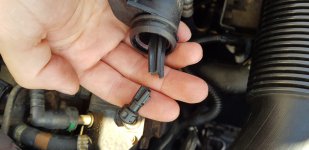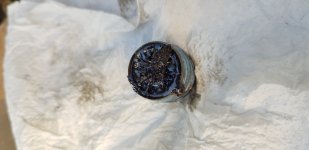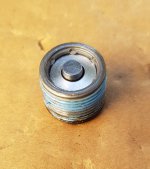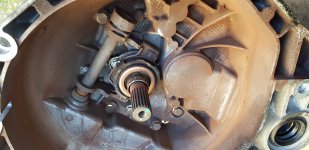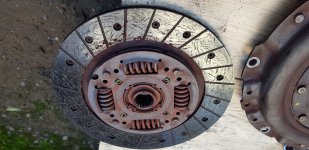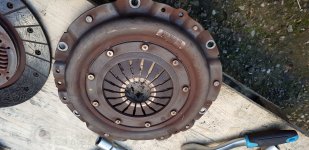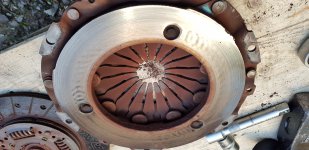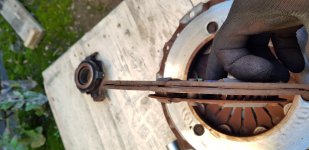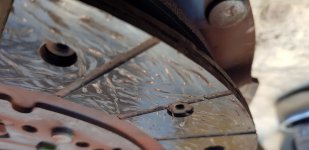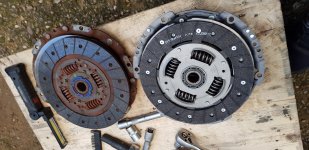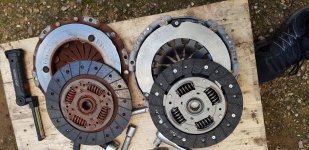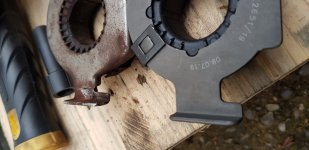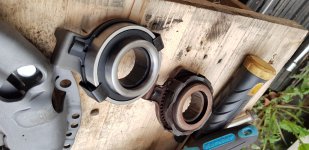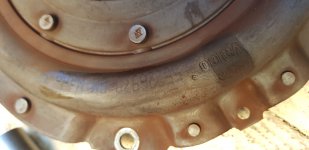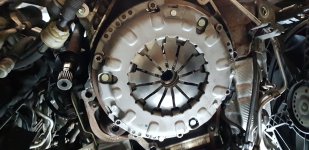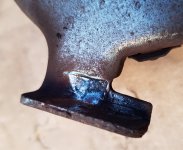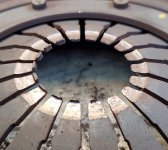What brand was the slave cylinder so others can avoid them?
Chris, the brand is Febi Bilstein, a known good brand I must say, I know their filters are up there with the most expensive ones, that's why I never expected this from them. I guess, lately it's becoming harder to stay in business by maintaining a good quality and competitive prices. They made the wrong choice here. This is not a part you can compromise on quality!
So, the clutch on the van was indeed the OEM one, you can see the part numbers in the pictures. The clutch disc itself still had about 70% of life left, if not more, even the thrust bearing was OK, apart from the wear on the backside where the fork was making contact. And also, for who might want to know, thers is a solid mass flywheel fitted on this engine!
But the part that was causing the problem, it is definitely the clutch plate, just look at that wear, in this case, it has lost the battle of hardness with the bearing. With the rest of the clutch kit in such good condition, I really think this is one of the cases Jock wanted to point out. Problem is not sitting with your foot down on the pedal at the traffic lights, in that case the bearing would have lost the battle in the long run, it's the habit of resting your food on the clutch pedal, only its weight, is enough to cause the hydraulic system to transfer
some movement to the thrust bearing, keeping it only slighty engaged with the clutch plate, like "stroking" it if that helps, gently enough, to keep a difference in rotation speeds between them, causing wear on both surfaces. I am sure the bearing is also worn, the contact surface is not as "tall" as it was, it's just not as noticeable due to the fact that is a continuous ring, and it has even wear. We can't say the same about the clutch plate. Is is deeply grooved, and it has uneven wear, probably because the bearing was not applying the force right to the centre anymore, due to the wear on it's back. This translated into a partial disengagement once the fingers got hot enough.
The clutch I fitted is from AP, because it was recommended by someone that changes only clutches for a living, being more sturdy in this case, and I wanted for once to try something other that Valeo or Luk.
The most surprising bit about this kit is how soft the diaphragm spring is! I mean, I knew that the aftermarket clutch kit has a softer spring than the used oem one, but my God, what a difference! I mean compared to my Passat which has 140000 mile still with its original clutch, the vans clutch pedal was way softer, and now I got this. It is so soft I actually thought there's something wrong either in there, or with the hydraulic system. I am not exaggerating when I say that it is almost as soft as my accelerator pedal??. But then I have observed that there's a full travel for my slave cylinder, and reluctanly?, decided to change gears with the engine on. And what a change!??
It actually changes gears with the engine on, the same way it does with the engine off! Which in my van's case, there was a huge difference. What more can I ask? It is a pleasure to drive it now. I'll have to see in the future which cluth part will fail first in this AP kit. I suppose the biggest factor in this case would be driving style, but I know that with me, it will have quite a long life.
Please check out the pictures, maybe it will help more with what I just wrote. I tried to make a comparison between the two kits in some of them. Also notice the gearbox draining plug?! All that fine metal, the result of thousands of miles with a worn clutch.
I am sure a lot of gearboxes got wrecked before someone thought about attaching that strong neodymium magnet to the plug.
It also deserved new transmission oil. Tutela Gearforce 75W, just what the manufacturer recommends on these models.
I am glad I got this sorted, not easy to do it by yourself, and on a driveway, but totally doable if you have the tools and passion.?


